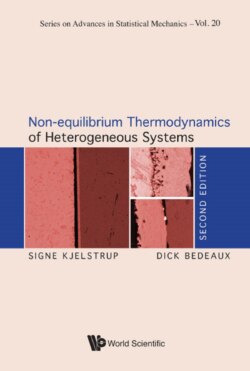Читать книгу Non-equilibrium Thermodynamics of Heterogeneous Systems - Signe Kjelstrup - Страница 28
4.1Balance equations
ОглавлениеThe balance equation for component j is
| (4.3) |
where Jj(x, t) are the component fluxes in the laboratory frame of reference, all directed along the x-axis. Furthermore, νj is the stoichiometric constant of component j in a chemical reaction, which is positive if j is a product and negative if j is a reactant, and r(x, t) is its rate in the volume element. For simplicity, we consider only one reaction. It is easy to add more reactions [23]. The reaction Gibbs energy is
| (4.4) |
In our description of reactions at surfaces, we shall also need the contribution to the reaction Gibbs energy due to the neutral species
| (4.5) |
where the sum in Eq. (4.5) is only over the neutral components. The difference between ΔnG and the usual expression ΔrG is due to the chemical potentials of ions and electrons. We explain why we need ΔnG in Secs. 10.6 and 10.7.
Exercise 4.1.1.Derive Eq. (4.3) for r = 0 by considering changes in a volume element that is fixed with respect to the walls.
•Solution: The change in the number of moles of a component Nj(t) in a small volume V is due to the flux of the component in and out of the volume. We have
where Ω is the cross-sectional area of the volume orthogonal to the flux direction (the fluxes are flows per unit of area). The area is equal to the volume divided by dx. In the limit of small dx, we have
By dividing this equation left and right by the (constant) volume, one obtains Eq. (4.3).
The conservation equation for charge is
| (4.6) |
where z(x, t) is the charge density. The systems that we consider can all be described as electroneutral. It follows that ∂j/∂x = 0 so that the electric current density j is constant. The electric current is due to the relative motion of the charge carriers in the system, like for instance of electrons relative to the metal ion lattice. This relative motion is such that it preserves charge neutrality.
According to the first law of thermodynamics, the change in internal energy density per unit of time is equal to:
| (4.7) |
where Jq(x, t) is the total heat flux in the laboratory frame of reference. The product [∂ϕ(x, t)/∂x]j is the electrical work done to the volume element. The time derivative of the polarization density is the displacement current, jdispl(x, t) ≡ ∂P(x, t)/∂t. The product E(x, t)jdispl(x, t) gives the work per unit of volume by the displacement current. This is a capacitive contribution which, for instance, is important when there is an oscillatory electric field (see Chapter 21). In the appendix at the end of this chapter, a discussion is given for the relation between Eq. (4.7), the first law, the definition of the total heat flux, and the relation between ∂ϕ(x, t)/∂x and E(x, t). An important assumption in the derivation of Eq. (4.7) is that the system is in mechanical equilibrium, a condition we shall use throughout this book. Contrary to the situation in vacuum, the electric field in a medium is not a conservative field.
The total heat flux across the volume element is given by
| (4.8) |
It consists of the measurable heat flux J′q(x, t) and the partial molar enthalpies Hj(x, t) carried by the neutral component fluxes Jj(x, t). The measurable heat flux is independent of the frame of reference. This is not the case for the total heat flux. We discuss the frame of reference further in Secs. 4.2, 4.4, and also in Chapter 12, which deals with multi-component diffusion. The first law is illustrated in Fig. 4.2. De Groot and Mazur [23] used charged and uncharged components, which are appropriate for systems that are not electroneutral, and defined a reduced heat flux in analogy with Eq. (4.8). In the electroneutral systems, which we consider, it is more appropriate to use the smaller number of uncharged components. The measurable heat flux differs from the reduced heat flux by a contribution proportional to the electric current density, see Appendix 4.A for a discussion.
Figure 4.2The energy change of a volume element with fluxes of heat and charge across the boundaries.
